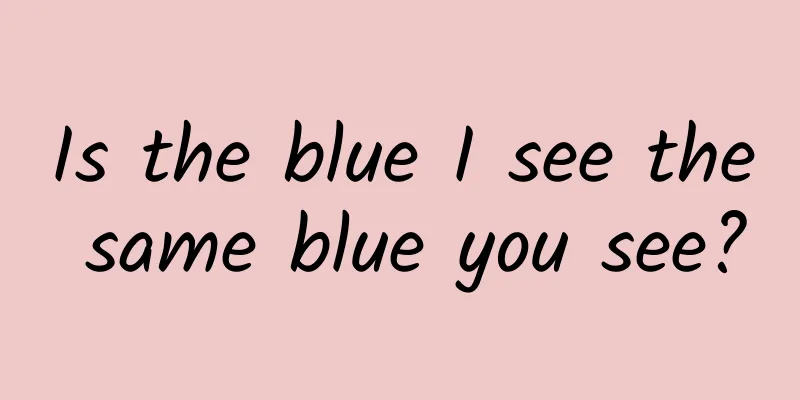Is the blue I see the same blue you see?

|
The differences in the physical structure of the eye, the way the brain processes images, the variety of languages used, and the environments in which we live all combine to give us all unique ways of capturing and describing the world. By Nicola Jones Translation: Li Ke Proofreading and translation| Chen Xiaoxue Image color may seem like a physical reality, but our perception of it is influenced by everything from biology to psychology to culture and language. Image credit: Knowable Magazine If I asked you what color a tree is, what color the sky is, and what color a sunset is, you'd think the answer would be obvious. But it turns out that the way people see the world varies a lot from person to person and from culture to culture. The physiology of the eye, the way the brain processes images, and the language used to talk about color all influence how we perceive and talk about color, and there is room for variation in these factors themselves. Judging from the physiological structure of the eye, most people have three types of cones, including short-wave cones, medium-wave cones, and long-wave cones. As light receptors of the eye, different types of cones are responsible for sensing light of different wavelengths. However, some genetic mutations can cause a certain type of cone to become abnormal or completely lost, leading to changes in individual color vision. These individuals may be what we usually call color blind, or they may be people with super powers of color perception. In addition, gender, age, time and season of birth, and even the color of the iris will affect the way we perceive color to varying degrees. So, what other interesting questions are there about differences in color vision? Recently, Knowable Magazine interviewed Jenny Bosten, a visual neuroscientist at the University of Sussex in the UK, who published a research paper related to human color vision differences in the 2022 Annual Review of Vision Science. Q1: How many colors are there in a rainbow? Jenny Burton: Physically, the rainbow is a continuous spectrum. In the visible range, the wavelength of light changes smoothly between the two ends, without lines or sharp interruptions. Within this range, the human eye can distinguish far more than seven colors, but we usually say that the rainbow has seven colors: red, orange, yellow, green, blue, indigo, and violet. This is the influence of history and culture on the description of color vision. Q2: Did you tell your own children the same thing? They are now 10 and 5 years old? Jenny Burton: I didn't teach them anything about color because I was interested in observing their natural perception of color. For example, my 5-year-old daughter would say, "Are we going to that blue building?" And to me, it's a white building against a blue sky. Others say that children initially call the sky white, and then they slowly learn to perceive it as blue. I'm interested in observing all these underlying things in children. Q3: Most people in the world have the same view on the basic hues of red, yellow and blue, right? Jenny Burton: There is already some big data that records the color classification forms in different cultures, and the data shows that these classifications have some commonalities. This shows that humans have certain biological limitations when learning to classify colors. But not every culture has the same number of categories. Therefore, some people believe that color classification is cultural, and the evolution of color culture has caused color classification to change. A culture's language may initially make only two or three distinctions between colors, and over time the categories grow in complexity. For example, in Old Welsh, there was no distinction between blue and green; both belonged to the category of "Grue". Russian, on the other hand, has two words for blue alone: "siniy" (dark blue) and "goluboy" (light blue). So, can we say that speakers who make these distinctions have different perceptions of color? Or is it just a linguistic thing? I don't think the jury is still out. Q4: In 2015, there was a debate online about whether a dress had white and gold stripes or blue and black stripes. Why did people have such different opinions? Jenny Burton: Scientists were also very interested in this photo. There were a lot of studies on it at the time, and even a journal devoted an entire issue to the topic. The consensus reached by these studies was that the color you see the dress in depends largely on the light you think it is in. Someone who thinks the dress is blue and black will see the light as a bright yellowish color, while someone who thinks the dress is white and gold will see the light as a hazy blue. In other words, it is the brain that ultimately determines the light of the dress. Different people interpret the famous 2015 "dress" photo in different ways, depending on the lighting situation their brain assumes. Image credit: KNOWABLE MAGAZINE Modified from DH BRAINARD & AC HURLBERT / CURRENT BIOLOGY 2015 Q5: One of the most obvious reasons for differences in color vision between individuals is abnormalities in cone cells caused by genetic mutations. How many types of these abnormalities are there? Jenny Burton: Humans have three types of cones, and the number of possible combinations is enormous. We are currently more familiar with the variations of long-wave cones (L, which mainly sense red light) and medium-wave cones (M, which mainly sense green light). These two cells express corresponding light-sensitive opsins, which change shape when light is received and determine the cell's sensitivity to wavelength. The gene encoding each opsin has seven polymorphic sites, so the number of possible combinations is very large. Q6: A common color vision variation is red-green color blindness. What causes it? Jenny Burton: Red-green color blindness is a severe red-green color vision defect caused by abnormalities in L-type or M-type cones. Patients may be missing a certain type of cone, or their two types of cones may not function. Red-green color vision deficiency is also known as Daltonism, named after the British chemist John Dalton (September 6, 1766-July 27, 1844). John thought his color vision was not significantly different from that of most people, but he found that in some cases, his description of color was different from that of the people around him, but the same as that of his brother. He thought it was caused by an extra filter in his eyes. Many years later, scientists sequenced his DNA and detected that he was a dichromat. Another milder type of color blindness is anomalous trichromats. These people still have the two different types of cones mentioned above, but the two types of cones that should recognize different wavelengths of light will show similar wavelength recognition ranges, so the range of their perceived difference between red and green will be narrowed. Most people have three types of cone photoreceptors in their eyes, each most sensitive to a different wavelength, or color, of light. Some people have defective or missing cones, and some have four different types. Image source: WIKIMEDIA COMMONS KNOWABLE MAGAZINE Jenny Burton: For dichromats, they've basically lost an entire axis of color vision, and their color vision is one-dimensional. As for what that looks like, it's hard for me to say, because we don't know subjectively what the two ends of that dimension are. It's usually described as the axis between violet and lime green in normal color space. But in reality, it could be any two perceived hues. We don't really know that yet. Some dichromats have only one abnormal eye. When researchers asked them to match the colors they saw with their dichromats to the colors they saw with their normal trichromats, they found that sometimes they saw more colors with their dichromats than we would expect. But we don't know if this is typical of what a dichromat sees, because they don't have a trichromat to help connect the dots in their brain. Q8: Does color vision abnormality always make colors monotonous? Are there some gene mutations that can enhance color perception? Jenny Burton: In most cases, color vision abnormalities result in fewer colors being discerned. However, in some special cases, anomalous trichromats have cones that are sensitive at different wavelengths, allowing them to distinguish certain colors that normal trichromats cannot. This phenomenon is called observer metamerism. There are also tetrachromats, people who have two X chromosomes that carry genes for both variant cone opsin molecules and normal cone opsin molecules. We know that such people exist, but we don't know if they can use their extra cones to gain an extra dimension of color vision, seeing colors that normal trichromats can't see or distinguish. For anomalous trichromats, there was a test where the observer had to mix red and green light to make a yellow color, and some people couldn't find any mixture that matched yellow. They needed three colors mixed together, not two. So they had four primary colors instead of the usual three. It's hard to prove how or why this happens, or what exactly they see. Similar images are often used to determine if a person is color blind. Most people can see the numbers in the circles, but people with defective color vision, missing or altered cone cells, may not be able to distinguish the numbers in color. Q9: Do these people know that they have super color vision? Jenny Burton: We recruited women who didn't know their color vision status. More than 50% of them had four types of cones. But usually, two types of cones are only slightly different, so that might not be enough to produce tetrachromacy. People's subjective experience of color is very private, and it's hard to know how your color vision compares to those around you. John Dalton was the first person to discover red-green color blindness, in 1798, which is itself quite recent. His was a severe form, but he wasn't entirely sure about it. Q10: Besides genes, are there other biological differences that affect color vision? Jenny Burton: The lens of the eye turns yellow with age, especially after the age of 40, and this change reduces the amount of blue light reaching the retina. Lutein and zeaxanthin, also known as macular pigments, are pigments that absorb blue light and filter out ultraviolet light. Diet can greatly affect the deposition of macular pigments, which come from vegetables such as green leafy vegetables. The more you eat, the more pigment you will get. In addition, there is some small correlation between iris color and color discrimination ability: it may be a determining factor in your ability to distinguish very precise colors. People with blue eyes seem to perform slightly better on color discrimination tests than people with brown eyes. Q11: Is our perception of color also affected by our surroundings? In other words, if I grew up in a green jungle, or in a yellow desert, would I distinguish more colors in those areas of the rainbow? Jenny Burton: Yes. This is a hot topic of research in color science right now. For example, whether a language has separate words for green and blue seems to depend to some extent on whether a cultural group lives near large bodies of water. Again, this is a linguistic question, and we don't know whether it affects their actual perception. The perception of yellow is also affected by the seasons. A study in York analyzed the phenomenon of "winter is grey and gloomy, and summer is green and beautiful". They found that people's perception of the wavelength of pure yellow changes with the seasons. Although the changes are small, they are still measurable. The season you're born in also has an effect on your color vision, especially if you're born in the Arctic Circle. This may be related to the color of light you were exposed to during your visual development. Environmental influences can affect color perception in two opposing ways: different environments can lead to individual differences in perception, but shared environments can also offset biological differences and make people's color perception more similar. Q12: With so many differences, it seems hard to unpack them all or distinguish whether they are biological or cultural. This really brings us back to the philosophical question: Is the blue I see the same blue you see? Jenny Burton: Yes. I have always found color to be a very fascinating thing, especially the subjective experience of color. How the brain perceives this is still a mystery. I have been thinking about this question for a long time before I decided to devote my career to studying it. Copyright Notice: Source: Mr. Sai |
Recommend
When will Jilin be unsealed in 2022? When will it end exactly? Attached is the latest news on the full unblocking
Since April, the news about the local epidemic in ...
Latest news! The Shenzhou 15 crew plans to return home in June
According to the China Manned Space Engineering O...
A piece of ginkgo leaf you picked up may come from billions of years ago
As the temperature gradually drops, the ginkgo be...
Douyin Enterprise Certification Review Standard Guide!
Douyin's "Enterprise Certification"...
If your head itches, don't scratch it! Be careful of this skin disease, which will not only leave scars but also cause hair loss...
When you are bored, irritable, or have a hard tim...
Official first revelation: Does a bracelet tied to a dog count as WeChat steps?
Since WeChat launched the walking rankings, many f...
What taboos should we pay attention to when placing the Wenchang Tower?
Wenchang Tower is a relatively special kind of ha...
Can ordinary masks be transformed into N95 masks by tying a knot? Is it really that magical?
[This issue's rumor]: Recently, a video title...
Gaming on smartwatches: Break through or stop
Editor's note: I always think that making gam...
A tough New York designer teaches you the four principles of app design
The most interesting thing about design is its un...
Scalpers resell Tesla Model 3 reservations and earn 300% profit
According to a report by the financial website Ma...
2019 New Advertising Law Banned Words, New Advertising Law Regulations!
As businesses and marketers, we must always pay a...
What happens if Baidu's bidding keywords can only be ranked first on the right when there is no competition on the left?
Browser display problem: The search results and a...
Can you still pee properly? So many people have overactive bladders...
Leviathan Press: It is estimated that many people...









